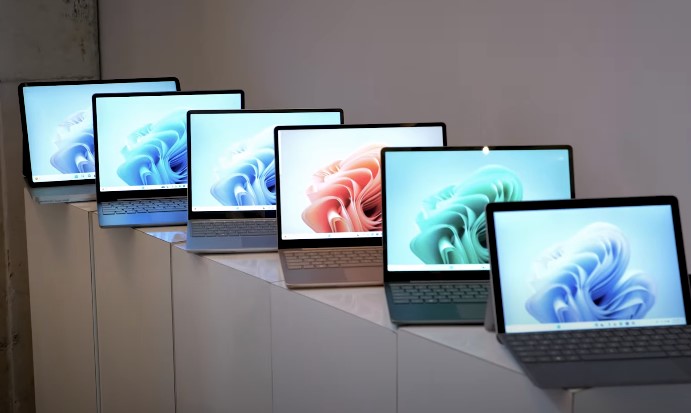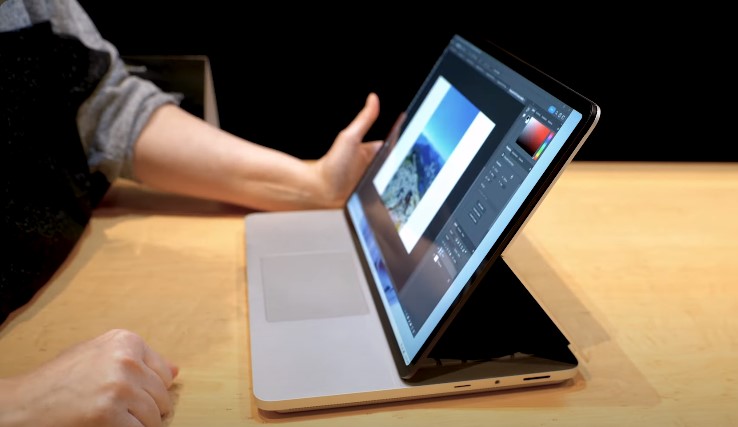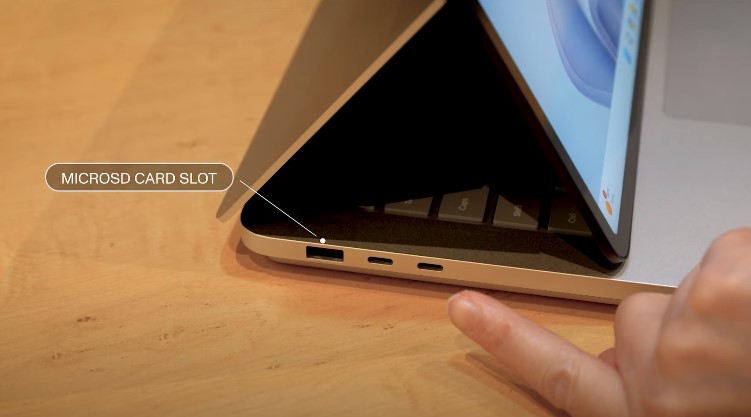Technology has come a long way in recent years, but only a few moments in history stand out as true game-changers. As we stand on the brink of a new decade, Microsoft, a giant in the tech industry, is leading us into a transformative phase of digital exploration. With the unveiling of its latest devices, the Surface Studio 2 and Surface Go 3 laptops, Microsoft is not just making a mere announcement but sounding a clarion call to enthusiasts, professionals, and everyday users alike, signaling the start of a novel computing epoch.

These devices are not just products but visions of the future, meticulously crafted and brought to life. Every design aspect, software integration, and hardware enhancement echo a commitment to redefining our interaction with technology. As we explore the intricacies of these groundbreaking devices, it becomes clear that Microsoft’s latest offerings are more than just technological marvels. They are harbingers of a future where boundaries between man and machine blur, where computing becomes not just a task but an experience.
Let’s not simply consider the Surface Studio 2 and Surface Go 3 as laptops. Instead, let’s recognize them as the pioneers of a new era, shaping the path of the digital journey to come. Prepare to embark on an enlightening exploration of the features and capabilities of these devices and see for yourself how they are molding the future of computing.
Table of Contents
Microsoft Surface Studio 2 & Surface Go 3 Laptops
Design and Display
The Microsoft Surface Studio 2 was launched, it became an instant sensation. One of the most striking features of this amazing device was its stunning minimalist design, which was highlighted by its sleek lines and chrome-finished base. However, the real showstopper was the 28-inch PixelSense display, which was capable of transitioning from a traditional desktop angle to a flat, table-top orientation. This feature made it a favorite among artists, architects, and designers who were looking for a large, precise canvas to work on. The display’s rich color reproduction and touch sensitivity made it an even more attractive tool for professionals who needed a device that could match their vision and creativity.

The Surface Studio 3, on the other hand, retained the foundation of its design but introduced new, subtle yet significant refinements. The hinges, which are a critical component of the Studio experience, were re-engineered for smoother transitions, making it even easier to adjust the display. The display, which was already a marvel in the Studio 2, saw improvements in terms of brightness and color accuracy, making it even more vibrant and immersive. Microsoft’s commitment to offering a tactile, immersive experience was evident in every design choice they made for the Studio 3, making it a device that is not only beautiful but also incredibly functional.
Performance and Power
Microsoft Surface Studio 2 was a computing powerhouse, equipped with 7th and 8th generation Intel Core processors and the formidable NVIDIA GeForce GTX 1070 graphics. Its impressive specifications made it capable of handling even the most resource-intensive tasks, from complex 3D rendering to demanding video editing and real-time simulations. The Studio 2 was a reliable and robust performer that delivered exceptional results every time.

The Surface Studio 3, however, took performance to a whole new level. With cutting-edge components that vary based on configurations, including newer generation Intel chips and potentially more advanced graphics options, Microsoft clearly aimed for the zenith. They weren’t satisfied with merely being ‘good enough’; they aimed to set new industry standards. The Studio 3 has already received glowing reviews and positive feedback from users, indicating that it surpasses its predecessor and raises the bar for computing performance.

Whether you’re a gamer seeking unparalleled graphics, a creator looking for seamless software experiences, or a professional needing multitasking prowess, the Studio 3 promises to be a reliable and trustworthy companion that will never let you down.
Features and Functionality: Innovating the User Experience
The Surface Studio 2 was a trailblazer in terms of combining raw power and aesthetic design with nuanced features and innovations. Its integration with the Surface Pen provided artists and designers with a level of precision that was previously unprecedented. The device’s touch sensitivity, coupled with the Pen’s pressure recognition, unlocked a world of digital artistry that was both intuitive and expansive. Furthermore, the Studio 2’s seamless integration with Windows 10 ushered in a suite of features that enhanced productivity, from gesture controls to facial recognition.

The Surface Studio 3, however, has taken things to the next level with a host of enhancements that make it stand out in the tech world. Early reviews and rumors suggest a more advanced Surface Pen experience, potentially offering tilt functionality and even greater pressure sensitivity. But the Studio 3 is not just about the Pen. It is also expected to have better integration with Microsoft’s suite of AI tools, which will pave the way for smarter assistance, predictive text, and more streamlined workflows. These subtle yet powerful features will greatly enhance the user experience, making tasks smoother and more intuitive.

Co-Pilot: Microsoft’s AI Revolution
As we look at the vast canvas of technological advancements, Artificial Intelligence (AI) is considered to be one of the most important technological advancements of our time. Microsoft, being a pioneer, has yet again showcased its exceptional capabilities by introducing “co-pilot” – an AI-powered tool that redefines the boundaries of human-computer synergy, paving the way for a new era of intelligent computing.

In the digital realm, AI’s potential has often needed to be utilized or untapped. However, with co-pilot, Microsoft is not just integrating AI into its ecosystem. It is completely reimagining how we interact with technology. Co-pilot, seamlessly woven into the upcoming Windows 11 update, promises to elevate mundane tasks into intuitive experiences, bridging the gap between user intent and computational capability.

As we move into an era where technology is no longer just about executing commands but understanding context, co-pilot is a testament to Microsoft’s forward-thinking approach. It is not just about making software smarter; it is about making our interactions with technology more human and organic. With its promise of enhanced user experiences, this AI companion signifies a paradigm shift. It represents a move from reactive computing to proactive assistance.
Co-pilot is not just another feature; it is a bold statement. It is a proclamation that Microsoft envisions a future where technology does not just serve but collaborates, understands, and evolves with us. As we stand on the cusp of the AI revolution, it is evident that with co-pilot, Microsoft is setting trends and charting new horizons in the digital landscape.
FAQs of Surface Studio 2 & Surface Go 3
1. What is Surface Studio 2?
The Surface Studio 2 is a premium all-in-one desktop computer designed and produced by Microsoft. It’s part of the Surface lineup and is known for its sleek design, high-resolution touch-sensitive display, and its ability to tilt and lay flat, making it ideal for artists, designers, and professionals. The device seamlessly combines powerful hardware with an elegant design, offering a unique computing experience.
2. When was Surface Laptop Go 3 released?
There seems to be a slight confusion here. The “Surface Laptop Go” and “Surface Go 3” are two different products in Microsoft’s lineup. The Surface Go 3, as mentioned, was released in 2021. The Surface Laptop Go, on the other hand, was introduced in October 2020. As of my last update, there hasn’t been a product named “Surface Laptop Go 3.”
3. What CPU does the Surface Studio 2 have?
The Surface Studio 2 features Intel Core processors. Depending on the model and configuration, it can be equipped with either a 7th generation Intel Core i7-7820HQ or an 8th generation Intel Core i7 processor. These powerful CPUs ensure smooth performance, quick multitasking, and efficient handling of resource-intensive applications.
4. How many GB is Surface Go 3?
The Surface Go 3 offers different configurations in terms of RAM and storage. For RAM, you can choose between 4GB and 8GB options. As for storage, the Surface Go 3 provides options ranging from 64GB eMMC to 128GB and 256GB SSD variants. The exact storage and RAM would depend on the specific model and configuration you opt for.
5. How fast is Surface Studio 2?
The speed of the Surface Studio 2 is determined by its robust combination of CPU, graphics card, RAM, and SSD storage. With its Intel Core i7 processors, NVIDIA GeForce graphics, and options for up to 32GB RAM and 2TB SSD, the Surface Studio 2 is designed for rapid boot times, swift application launches, and smooth multitasking. Specific performance metrics might vary based on the exact configuration and the tasks being performed, but overall, the Surface Studio 2 is built for speed and efficiency.
6. What graphics card does the Surface Studio 2 have?
The Surface Studio 2 comes equipped with NVIDIA GeForce graphics. Depending on the specific configuration and model you choose, it can have either an NVIDIA GeForce GTX 1060 with 6GB GDDR5 memory or an NVIDIA GeForce GTX 1070 with 8GB GDDR5 memory. These graphics cards ensure that the device can handle graphic-intensive tasks such as video editing, 3D modeling, and gaming.
7. Is Surface Go 3 a good computer?
The Surface Go 3 is a versatile and compact device designed by Microsoft as part of its Surface lineup. Its performance and suitability largely depend on the user’s needs. For everyday tasks like browsing, document editing, and media consumption, it’s an excellent choice. Its portability makes it ideal for students and professionals on the go. However, for resource-intensive tasks like high-end gaming or professional video editing, there are more powerful devices in the market. Overall, the Surface Go 3 offers a good balance between performance, portability, and price.
Conclusion: A Duel of Elegance and Power
When it comes to comparing the Surface Studio 2 and Surface Studio 3, it’s no easy task as both devices are unique in their own ways. The Surface Studio 2, which was released earlier, was a device that revolutionized the premium desktop market with its groundbreaking features and benchmarks. It proved to be a game-changer for users, setting new standards for the industry.

On the other hand, the Surface Studio 3 represents an evolution of its predecessor. It takes the best features of the Studio 2, enhances them, and introduces new features that cater to the ever-changing needs of modern professionals. This device is a clear indication of Microsoft’s commitment to continuous improvement and their vision for the future of computing.
In conclusion, both devices have their strengths and weaknesses, and choosing between them ultimately depends on individual needs and preferences. For those who value stability and proven performance, the Surface Studio 2 remains a formidable device. However, for those who seek the latest technology, innovations, and a glimpse into the future of desktop computing, the Surface Studio 3 is undoubtedly the clear frontrunner.



